40th Anniversary
Manchester Cross‑Country Ski Club: A Short History From its Origins to the Present Day
|
| |
The decisive factor that has influenced the club’s development since its inception in 1984 is the presence or absence of local snow. Whether in our parks, golf courses and public gardens or on the trails and slopes of the Peak District, Wales and Scotland, this welcome but erratic supply of winter snow between November and early spring in the early to mid 1980s was an invitation to Nordic skiing and to the activity of cross‑country ski clubs.
|
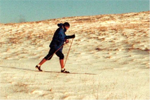
Skiing in North Wales (1986)
|
The Manchester club first got going thanks to meetings in Altrincham pubs in the winter of 1983/4 of interested parties and enthusiasts who had already done some skiing, usually Alpine, but who also wanted to try Nordic, such as Nigel James, Archie Bradley, Ralph White and Dave Pearce who ran a winter sports shop in Altrincham. Out of these meetings arose the decision to start and develop a cross‑country ski club. First meetings of this group followed, usually in each other’s houses, a committee structure soon emerged, and the main lines of the club’s activities and programme were set out. These remained fairly constant throughout the 1980s and 1990s, such that the club developed strongly in this period, becoming one of the biggest and most active in the country by the end of the twentieth century.
|
|
Much of what was achieved in these early years reflected the work of the club committee and the willingness of members to serve on it. Offices changed hands, but the main contributors in this period were Nigel James as Chair and Newsletter Editor, Archie Bradley as Treasurer, Rhod Taylor as Secretary, Peter Morgan as Outdoor Meets Organiser, Mike Trude as Indoor Meets Organiser, Phyllis Oldfield as Membership Secretary, Ralph White as Chair and Newsletter Editor, Pat Phillips as Editorial Assistant, and Peter Kirby, who was responsible for equipment hire. Others who soon joined through personal contact and who played roles in these formative years include Frank and Rachel Cosgrove, Bob Scoltock, Heather Elliott and David Painter, Nick and Jayne Davies (who later became Secretary).
|

Macclesfield Forest (1989)
|

|
The committee agreed that the club should have a newsletter that came out every month or so, outlining the activities of the club per se and those of individual members, as well as sharing information such as the location of equipment shops and details of companies such as Waymark and Highland Guides that promoted Nordic courses and holidays, and offering articles on Nordic technique and safety. These newsletters did much to create cohesion between members and to keep them informed about many facets of Nordic skiing. It was also agreed that the club should hold regular indoor meets every month during the ski season. Suitable rooms were found in south Manchester hostelries, and the membership were invited to a series of talks on many different aspects of cross‑country skiing: members’ own tours, companies’ holiday offerings and courses, and the possibilities of Nordic skiing in suitable parts of the Alps, Scandinavia and Scotland. Again, like the newsletters, these meets helped to keep members together and the illustrated talks shared vital knowledge that opened up everyone’s horizons as to what it was possible to do on Nordic skis. Outside the ski season, the club kept members active through bike rides and hill walking.
|
|
The actual skiing that the club did in these early years depended at first on falls of local snow, so the committee devised a Snowline whereby members could notify each other of where it had fallen and skiing was possible. The local parks such as Dunham Massey, Tatton and Lyme Park were prime centres, as were accessible routes and slopes in Cheshire and the Peak District such as Delamere Forest, Rushup Edge and Edale, the foothills of Snowdonia such as around Clocaenog Forest and above the Conway Valley, hills in the Lake District such as the Dodds near Keswick and others in the Pennines such as High Cup Nick above Dufton. Nigel James regularly visited Scotland, as did Bob Scoltock, having a special interest in an outstanding equipment centre in Braemar, to which many others followed them and which gave good access to touring around the Glenshee area in particular. Members reported on and supported various ski centres in the Lake District or Scotland which offered training and accommodation, such as Langden Beck or Glenisla. Even more ambitiously, members also travelled abroad to ski, principally to Norway, eventually finding a ski centre in the Telemark region called Kvitavatn which became a club favourite and to which members often returned later, sometimes on an individual basis, sometimes on club holidays, since both track and downhill skiing were available.
|
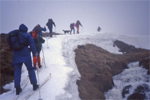
Touring in Ardenaig (1993)
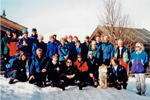
Club holiday in Kvitavatn (1997)
|
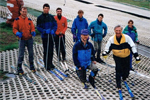
English Ski Council telemark course (Swadlincote, early 1990s)
|
However, snow in England was never reliable enough and so, after a poor winter in 1987, the committee agreed on two strategies to make the club less snow‑reliant: rollerskiing and dry slope skiing, since this was before the Chill Factore, the indoor ski slope in Manchester, had been built. The various early venues used for rollerskiing from the 1990s into the early 2000s were Wythenshawe Park, then Tatton Park and eventually the Fallowfield Loop in Chorlton‑cum‑Hardy, whereas Rossendale was the main local venue for dry slope skiing.
|
|
The club was able to promote these activities thanks to various members’ keen interest in learning how to teach these two types of skiing by becoming qualified through coaching courses run by what was then called the English Ski Council and is now Snowsport England. Ralph White was a leading light in this respect, being a dedicated coach in both rollerskiing and telemark/downhill who started many members off on their careers as skiers and often, later, as coaches in their own right, such as Alison Pawley, Alistair and Rosie Blades.
|
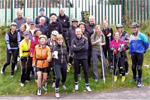
Fallowfield Loop rollerski coaching (2006) |

|
Alongside other clubs from London, the Yorkshire Dales and the Tyneside Loipers, members of the Manchester club served on Snowsport England’s various Nordic committees, becoming involved in the actual design of its various coaching awards and participating in many of the national debates about the future of the sport. The coaching provision offered by the club thus became a key draw for new members who were able to learn and hone their track and telemark/downhill skiing skills even in the absence of regular snow. As a result, the club’s membership grew quite strongly and, in 1995, just eleven years after it had started, the figure was over 70.
|
|
From the mid 1990s onwards, the club maintained its reputation for being one of the most active clubs in England, celebrating its 10th anniversary in 1994 in some style with a track skiing trip to Sjusjøen in Norway and a handbook that gave a very clear idea of how it had developed since the beginning. The newsletters continued to provide a full and lively account of what the club got up to and the indoor meets flourished, with inspiring illustrated talks that were usually well attended.
|

10 years already! (Sjusjøen, 1994)
|
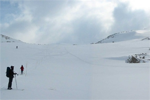
Hut touring in the Jotunheim (2003)
|
The coaching that the club provided on both rollerskis and dry slope skiing also evolved greatly in the following decades, stimulating many different types of activity on Nordic skis. Firstly, the club had a strong contingent of members who enjoyed hut to hut touring with large packs, mainly in Norway, skiing sticked routes through national parks such as Dovrefjell, the Hardangervidda, the Jotunheim and the Rondane, and staying in the vast network of serviced and unserviced huts run by the Norwegian DNT. Particularly keen tourers of this era were Brian Barr‑Taylor, Ros Brown‑Grant, Matthew Carter, Nick and Jayne Davies, Kathy England, Geoff Hollins, Nigel James and Gill Rimington.
|
|
Secondly, loppet racing really took off from the 1990s onwards, with club members competing in ski marathons all over Europe (Austria, the Czech Republic, Estonia, Finland, France, Germany, Italy, Poland, Switzerland) and in other parts of the world such as Australia, Canada and the US. Some members eventually completed enough races to become World Loppet Masters: Mike Trude was one such early Loppet Master, followed by later members such as Alistair, Kathy England and Mike and Helen Smith. One particularly enthusiastic racer, the late Alan Shepard, organised very successful trips for club members to take part in these events, using the days before the race to reconnoitre the tracks and to acclimatise to the conditions and altitude, as at the Engadin in Switzerland, the König Ludwig Lauf in Germany, and the Pustertal and Sgambeda in northern Italy.
|
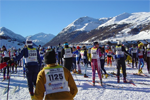
Getting ready to race at the Sgambeda, a 42km loppet event in Livigno (2004)
|

The North West Telemark Festival Race Group, Chill Factore (2017)
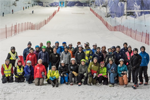
The North West Telemark Festival, Chill Factore (2018)
|
Thirdly, when the club transitioned from coaching and training on the dry ski slope at Rossendale to eventually using the newly built indoor ski slope at the Chill Factore in the early 2000s, telemark skiing exploded in popularity amongst members, whether they came from a track or back country skiing background or were converting from Alpine. Early telemark enthusiasts Ralph White and Nigel James were pioneers in this regard, taking other members on club trips to the telemark festival at Braemar/Glenshee, then further afield to Italy for the telemark festival at Livigno, and even to Canada (Banff and Lake Louise) for top‑class snow conditions. Similarly, other members did much of their early telemark training with John Eames and Bonnie Masson of the Telemark Ski Company in places like Tignes and La Thuile, taking one or two trips a year. However, the advent of the Chill Factore was a game‑changer: not only did the club have a first‑rate indoor slope on its doorstep but it also benefitted from the expertise of some of the best telemark coaches in the UK who ran regular sessions for its members from the 2000s onwards. Andy and Chris Stewart, Ian Johnston and John Holgate all initiated many members into telemark skiing and led others in their wake as coaches, such as Joyce Pemberton. The fact that the perennially successful North West Telemark Festival has been organised for many years by the club at the Chill Factor also attests to these coaches’ dedication, enthusiasm and sheer passion for the sport.
|
|
Finally, rollerskiing has become something of an activity in its own right as well as being a form of training for track skiing, loppet racing or hut‑to‑hut touring, particularly since the club moved about ten years ago to the cycle track at UCLan in Preston. This change in venue has not only meant that the club finally has regular use of a proper dedicated track but its location has allowed it to join forces with coaches from other northern clubs who are also Manchester members, such as Mike Smith (Lakeland). Although the club used to lead rollerski tours along cycle tracks in places like Chester (River Dee), the Lakes (Camerton to Whitehaven), Lancaster (Crook of Lune to Heysham), the Peak District (Manifold Trail, Upper Derwent Valley) and North Wales (Prestatyn to Colwyn Bay), these have been superseded in recent years by open track sessions at UCLan and Tameside cycle track. These sessions offer a more reliable and manageable way for skiers of all abilities to clock up the miles on rollers and are proving particularly popular with those members who have been coming on the club’s recent track skiing trips to Dobbiaco, with lessons provided by its own coaches such as Rosie Blades, Ros Brown‑Grant and Alison Pawley.
|
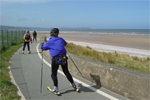
North Wales rollerski tour (2007)
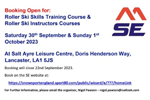
|
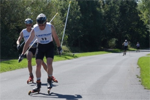
Rollerski racing at Lancaster (2017)
|
The Northern Roll challenge, involving collaboration between four clubs (Manchester, Lakeland, Yorkshire Dales and Tyneside Loipers), with Manchester’s event being organised at UCLan by Alistair, has also been a great way for skiers to compete, socialise, swap tips and plan holidays. Likewise, the annual rollerski skills course organised by the club at Lancaster on behalf of Snowsport England, most recently by Nigel Pawson, has become a key event in attracting new recruits to cross‑country skiing and in enabling the club’s skiers and coaches alike to continue developing their knowledge and expertise. This extensive rollerski provision has lately attracted to the club two Junior Biathletes – Finn Newton and Cara Loates (who has already become a rollerski instructor) – who are bringing a new dimension to the club’s activities and raising its profile both nationally and internationally.
|
|
In short, the club has come a long way in the forty years of its existence, but it has also changed along with the evolving snow conditions in the UK and beyond. If it no longer has its original south Manchester focus on indoor meets and regular excursions up to the Lakes and Scotland, it has nonetheless retained and developed its strong coaching tradition on all fronts, even if the telemark has now perhaps become more of a downhill than a touring technique. The fact that the club has come this far is due in no small part to many different people, to whom grateful thanks are due: to the founding and early members who started it off; to the long‑standing members who have remained involved over the years; to the more recent members who are now sampling the pleasures of Nordic skiing; to the coaches, both rollerski and telemark, who have given so much of their time and energy to teaching; and, finally, to the committee members both past and present who have administered the club, organised events and kept everyone informed and in contact with each other. What the next forty years may bring is, of course, up to the club’s present members to determine, so watch this space or, better still, have your say on how it should be filled…
|
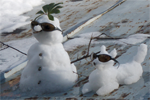
Looking to the future of the club…
|
| |
authors: Ros Brown‑Grant and Ralph White
publication date: December 2024 (presented November 2024 at MCCSC anniversary dinner)
This article is copyright of the Author and Manchester Cross‑Country Ski Club.
No part of the publication may be reproduced in any form or by any means in any other publication without the written permission of the publisher.
|
|

